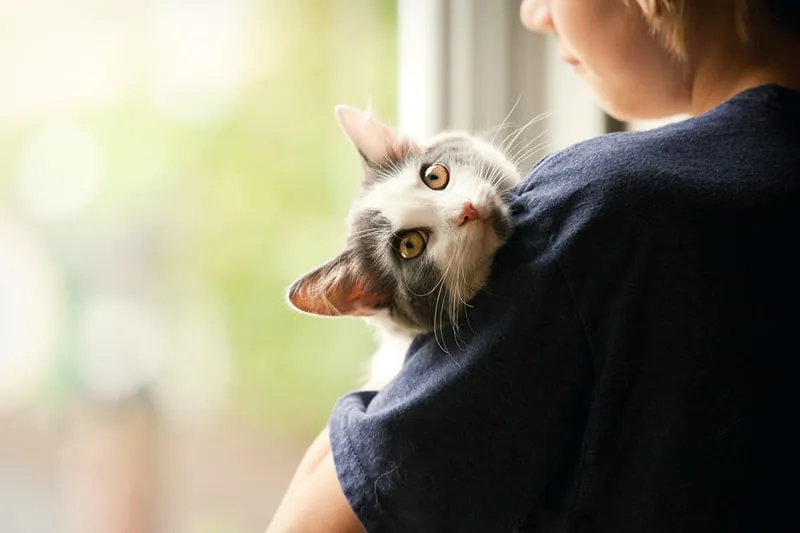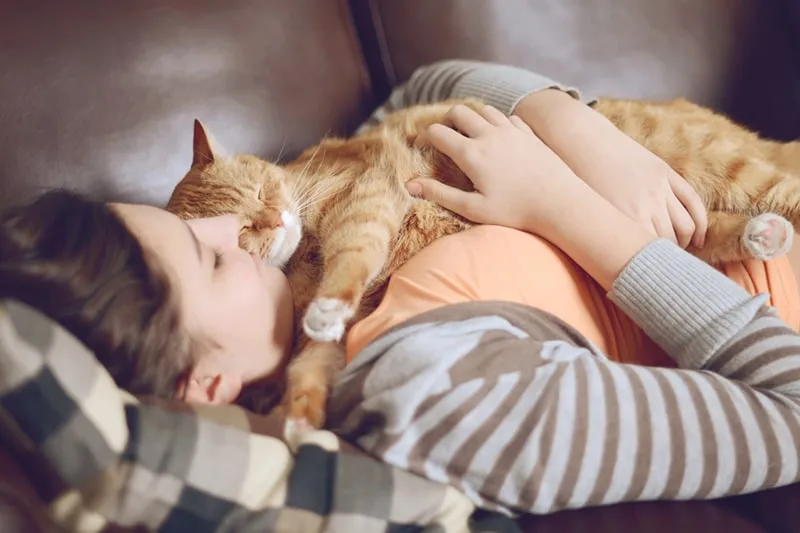Bringing a cat into your home offers boundless joy, from their playful antics chasing toys to the comforting purr as they curl up on your lap. They become cherished family members, brightening our lives in countless ways. However, alongside the love and laughter, comes the responsibility of providing for their needs – a commitment that includes various financial aspects. Understanding the Average Monthly Cost For A Cat, as well as the initial and unexpected expenses, is crucial for any prospective or current cat owner to ensure a stable and happy life for their feline companion.
Initial Investment: What Does It Cost to Bring a Cat Home?
The first cost you’ll encounter when acquiring a cat depends heavily on your chosen route: adoption or purchase from a breeder.
If you choose to adopt from a shelter or rescue organization, the initial fees are typically much lower and often include valuable veterinary services. Adoption fees can range from approximately $50 to $175, varying by shelter, location, and the cat’s age. Many shelter cats come already spayed or neutered, microchipped, and up-to-date on their initial vaccinations, significantly reducing your immediate veterinary expenses. This makes adoption a highly recommended option by organizations like The American Society for the Prevention of Cruelty to Animals® (ASPCA®), as it not only saves you money but also provides a loving home for a cat in need. Understanding the total financial commitment, not just the cat cost monthly, but also initial outlays and potential unexpected expenses, is crucial.
Conversely, purchasing a cat from a breeder is considerably more expensive. Pedigreed cats can cost $750 or more, often without including initial vaccinations or spay/neuter surgery. For a more complete picture of the long-term financial commitment, consider researching the lifetime cost of a cat.
Essential One-Time Purchases for Your New Feline Friend
Beyond the acquisition cost, welcoming a cat into your home requires an initial investment in fundamental supplies. The ASPCA estimates these capital costs, including initial medical care and spaying/neutering, can be around $365. However, this figure can fluctuate based on the specific items you select.
Must-Have Supplies: Setting Up Your Cat’s Environment
These items are non-negotiable for a cat’s health, safety, and comfort:
- Litter Box: A necessity for indoor cats, litter boxes come in a wide range of styles and prices. Basic plastic trays are affordable, while automatic self-cleaning models offer convenience at a higher cost. For multi-story homes, consider placing a litter box on each floor to ensure easy access for your cat.
- Carrier: An indispensable item for safe transportation to the veterinarian, groomer, or any other destination. Options vary from simple, inexpensive plastic carriers to more deluxe soft-sided bags, offering comfort and security.
- Collar and ID Tag: Even if your cat is microchipped, an easily visible collar with an ID tag is crucial. It provides immediate identification if your cat gets lost, acting as the first line of defense before a microchip scan.
- Scratching Posts or Mats: Cats have an innate need to scratch, which helps maintain their claws, stretch their muscles, and mark their territory. Providing sturdy scratching surfaces in designated areas is vital to protect your furniture and carpets from damage.
Don’t forget food and water bowls. While you can repurpose existing bowls, it’s important to choose ones that are easy to clean regularly to prevent bacterial buildup.
Optional but Beneficial Items for Enhanced Comfort
While not strictly necessary, these purchases can significantly enhance your cat’s quality of life and comfort within your home:
- Pet Bed: While many cats enjoy napping on soft blankets or towels, a dedicated pet bed offers a cozy, secure, and personal space for rest.
- Pet Fountain: Some cats are particularly drawn to running water, which can encourage better hydration. A pet fountain can be a worthwhile investment for these felines, promoting their overall health.
- Cat Shelves and Trees: Cats often enjoy observing their surroundings from elevated positions. Cat shelves or multi-tiered cat trees provide vertical space for climbing, lounging, and surveying their domain, which can reduce stress and boredom.
- Window Perch: A window perch allows your cat to safely watch outdoor activities, providing mental stimulation and entertainment.
- Pet Tech Gadgets: The market offers a variety of technology, from interactive laser toys to treat-dispensing cameras that allow remote interaction. These can be valuable for keeping your cat engaged, especially if you have long work hours.
 Young boy gently cradling a gray and white cat while looking out a window, symbolizing the joy and responsibility of pet ownership and the average monthly cost for a cat.
Young boy gently cradling a gray and white cat while looking out a window, symbolizing the joy and responsibility of pet ownership and the average monthly cost for a cat.
The Average Monthly Cost for a Cat: Recurring Expenses
Once the initial setup is complete, the focus shifts to the ongoing, recurring costs of cat ownership. According to the ASPCA, the average annual cost for a cat is around $634, which breaks down to approximately $53 per month. This estimate includes several key categories:
- Recurring Medical Expenses: Regular veterinary care is paramount for preventive health. This includes annual check-ups, booster vaccinations, and ongoing flea, tick, and heartworm prevention medication. These routine visits help catch potential health issues early, which can prevent more expensive treatments later.
- Cat Food: Providing a complete and balanced diet appropriate for your cat’s age, activity level, and any specific health needs is crucial. The cost of cat food can vary significantly based on brand quality (premium vs. budget), type (dry kibble, wet food, raw), and dietary requirements (e.g., prescription diets). Always consult your veterinarian for healthy food recommendations.
- Treats: Treats can be an excellent tool for training and bonding, but they should be given in moderation due to their calorie content and potential for unhealthy ingredients. Factor these into your budget, but prioritize high-quality options.
- Safe Toys: Toys are essential for a cat’s physical and mental stimulation, helping to prevent boredom, encourage exercise, and deter unwanted behaviors like scratching furniture. Rotate toys regularly to keep your cat engaged.
The ASPCA also includes an additional $30 annually for miscellaneous items, such as catnip, replacement scratching mats, or other small necessities. The actual average monthly cost for a cat can widely vary based on your brand choices and your cat’s specific needs and preferences.
Beyond these core expenses, your lifestyle may introduce other costs. If you work long hours or travel frequently, you might need to budget for a pet sitter or a boarding facility. Additionally, some apartments or condos may charge pet fees or increased security deposits to cover potential damages. When budgeting for the average monthly cost for a cat, it’s clear that food, litter, and routine vet visits form the backbone of recurring expenses.
Unexpected Costs: Preparing for the Unforeseen
Even with meticulous planning, unforeseen expenses can arise. Cats, despite their agility, can have accidents, or develop illnesses, leading to potentially costly veterinary bills. A missed jump could result in a fractured paw, ingesting a foreign object like string might necessitate emergency surgery, or a common upper respiratory infection could require medical attention. These emergency veterinary costs are impossible to predict but can significantly impact your budget.
Another common unexpected cost involves household damage. Those sharp claws can wreak havoc on carpets and furniture, and territorial spraying can leave difficult-to-remove odors. While proper training and enrichment can mitigate some of these issues, damage can still occur.
Mitigating Financial Risk: Understanding Cat Insurance Costs
One proactive way to prepare for unexpected veterinary expenses is through pet insurance. The cost of cat insurance varies depending on factors such as the level of coverage chosen, your cat’s age, breed, and your location. When exploring pet insurance plans, it’s vital to strike a balance between comprehensive coverage and affordability. A low-cost plan may seem appealing but might not provide adequate protection when your cat truly needs it.
If you opt for cat insurance, the monthly premium will become another recurring expense. However, many owners find that a predictable monthly premium is easier to budget for than the sudden shock of a large, unexpected veterinary bill, offering considerable peace of mind.
 Woman lovingly cuddling an orange tabby cat on a brown leather sofa, illustrating the bond with pets and the importance of managing the average monthly cost for a cat.
Woman lovingly cuddling an orange tabby cat on a brown leather sofa, illustrating the bond with pets and the importance of managing the average monthly cost for a cat.
Smart Strategies to Save on Cat Ownership Costs
While the financial commitments of cat ownership can accumulate, there are several clever ways to manage and reduce your expenses without compromising your cat’s well-being.
- Buy in Bulk: For non-perishable items like cat food, litter, and certain treats, purchasing in larger quantities often results in significant cost savings per unit. Ensure you have adequate storage space and check expiration dates, especially for food, to avoid waste.
- Shop Around: Prices for pet supplies can vary greatly between retailers, both online and in physical stores. Compare prices, look for sales, and consider signing up for loyalty programs or subscription services that offer discounts on recurring purchases.
- Make Your Own Toys: Cats are often entertained by simple, homemade toys as much as, if not more than, expensive store-bought ones. Cardboard boxes, paper bags (with handles removed), crumpled paper balls, or a feather tied to a stick can provide hours of enrichment.
- Whip Up Your Own Cat Treats: Creating healthy, homemade cat treats allows you to control the ingredients, avoiding unnecessary fillers and preservatives, and can be much more cost-effective than commercial options. Always research cat-safe ingredients and consult your vet if you have any dietary concerns.
- Consider Pet Insurance: As discussed, pet insurance can be a financial lifesaver during unexpected emergencies or prolonged illnesses. While it’s a recurring cost, it can prevent a single large vet bill from becoming a financial crisis, allowing you to provide the best possible care without economic strain.
Beyond these tips, focusing on your cat’s overall health through preventive care is the best long-term saving strategy. Ensure they maintain a healthy weight, receive appropriate exercise, drink plenty of fresh water, and eat a high-quality diet. Cat-proofing your home minimizes accident risks, and consistent love and attention contribute to a happy, less stressed cat, which can also indirectly reduce behavior-related issues and associated costs. While a cat’s expenses might seem daunting at first glance, understanding the various dog yearly cost comparisons and strategic saving can make pet ownership accessible and enjoyable.
Conclusion
Owning a cat is a rewarding experience that enriches lives with companionship and unconditional affection. However, it is also a significant financial commitment. By understanding the initial adoption fees or purchase prices, preparing for essential one-time purchases, budgeting for the average monthly cost for a cat, and planning for unexpected veterinary emergencies, you can ensure a stable and happy life for your feline companion. Proactive planning, informed decisions, and smart saving strategies empower you to provide the best possible care without financial stress. The joy a cat brings is truly priceless, but being financially prepared ensures that joy can be sustained for many years to come.
References
- ASPCA®. (n.d.). Pet Care Costs. Retrieved from https://www.aspca.org/sites/default/files/pet_care_costs.pdf
